|
Organizers
2002 workshop: |
PREVIOUS
| NEXT
PRESS RELEASE: WHAT GOES ABOVE GROUND ZERO HAS ONLY 5 PLANNING OPTIONS
Download
text only for printing: document<english>
| resumen
<espanol>
July
10th, 2002. There are only 5 planning options for the future of Ground
Zero according to a major workshop of architects, academicians, and students
who worked on solutions for the site as part of the "Internet Studio" program.
The "Internet Studio" is an international academic-consortium in which a large
number of architects, professors, citizens, government officials, and students
meet via the Internet and videoconference technology to discuss and design
strategies for controversial urban issues around the world. In the past month
the "Internet Studio" Network congregated to develop planning ideas for what
goes above ground at the former site of the WTC complex.
The workshop organized by members at the Schools of Architecture at Florida
International University in Miami, Center for Design Visualization at U.C.
Berkeley and Universidad Uniacc in Santiago de Chile.
Professor Alfredo Andia, Ph.D. an architecture professor from Florida International
University directed this workshop. According to Dr. Andia, "there have been
numerous efforts in the design community to put architectural images forward
for the future of Ground Zero, however, little emphasis has been placed on
defining the planning choices of the site. In this workshop, we have attempted
to see what are the real choices for the site. This is important because Ground
Zero is one of the most sensitive urban sites in the world today. The solutions
require an open participation of all those interested and a good understanding
of all the available options.
The Lower Manhattan Development Corporation (LDMC), who is in charge of the
site development, has a very difficult task. If images and/or planning solutions
are announced without a clear public understanding of the reasoning behind
the process then the solution may seem suspicious." Dr. Andia, the workshop
organizer, adds "to clarify the public process we found it extremely important
to investigate and try to exhaust all the possibilities that the site has
before trying to attempt any architectural move. We chose to concentrate on
what goes above ground on the site because that is the most controversial
part of the project; it should define the amount of infrastructure and transportation
that goes underneath."
According to the workshop, the solutions of what goes above Ground Zero fell
into 5 planning solution categories:
Option 1. 16-acre memorial super-block:
The first planning alternative considers the conservation of the 16-acre
super-block and uses it entirely for a memorial and related cultural activities.
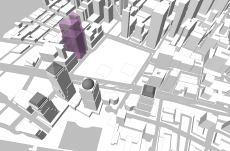
<
click here to enlarge description
of option 1 >
Option 2. 16-acre memorial using the old Manhattan Grid:
The second development option reintroduces the old Manhattan grid into
the site but leaves the entire 16 acres for memorial and related cultural
activities.

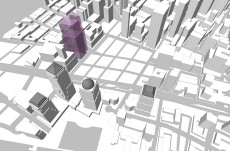
< click here
to enlarge description of option 2 >
Option 3. Mix memorial and office towers rebuilding the old Manhattan grid:
The third planning choice reintroduces the Manhattan grid and mixes a
program of a memorial with office and retail space. It leaves between 4 to
7 acres for a memorial and the reminder for office and retail development.
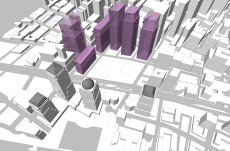
< click here
to enlarge description of option 3 >
Option 4. Mix memorial and office towers using the super-block:
The fourth option maintains the super-block structure and allows for the
development of an expressive architecture that combine high-rise towers and
a memorial.
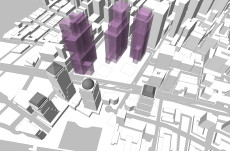
< click here
to enlarge description of option 4 >
Option 5. Rebuild the WTC complex:
The fifth option is the reconstruction of high-rise towers similar to
the WTC center. The idea had significant popular support right after September
11. And is the solution of choice for 48 % of more than 600 New Yorkers interviewed
by the NYPost on mid July 2002.
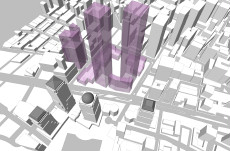
<
click here to enlarge description
of option 5 >
Summary
Of Discussion Regarding
The 5 Options One of the major concerns for those involved in the planning
process of the Ground Zero site is the position of the victims' families.
Today the families are congregated into approximately 6 different groups.
Although they do not have a unique vision for the site there is a consensus
among these groups that there should be a memorial in the former grounds of
the WTC complex. Among the most sensitive issues that have emerged in the
past 9 months, since September 11, are the footprints of the WTC center towers
1 and 2 where most of the victims died. The issues to be discussed in the
following pages are not simple and are particularly difficult to the victims'
families. The planning task is not easy. It is estimated that around 80,000
to 120,000 people are directly related to somebody who died in the towers
and many more citizens of New York are directly affected due to the events
of September 11.
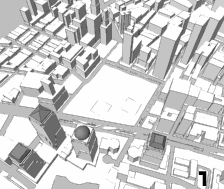
The primary conclusion of the workshop was that in spite of the different
views and interests people have regarding the future of Ground Zero the planning
strategies are very limited and can fall into 5 different alternatives.
The discussion that follows in the next pages attempts to clarify the arguments
and criticisms of these planning strategies.
Previous media pieces about "Internet Studio" workshops can be found at:
DISCOVERY CHANNEL, "Vida@Línea": http://istudio01.tripod.com/realdicover/discov28k.rm
BBC WORLD SERVICE, "Web connects design students": http://news.bbc.co.uk/hi/english/sci/tech/newsid_1544000/1544378.stm
BBC
MUNDO, "Arquitectura en red para A. Latina": http://news.bbc.co.uk/hi/spanish/science/newsid_1514000/1514682.stm
DIARIO EL CLARIN, Argentina, "La Entrega en Internet": http://istudio01.tripod.com/clarin.pdf
DIARIO LA HORA, Chile, "Estudiantes se Comunican Virtualmente": http://istudio01.tripod.com/lahora.jpg
NHK TV, Japan: http://istudio01.tripod.com/clip6.rm
GOVERNMENT VIDEO MAGAZINE, "Distance learning goes the last mile":
http://www.uniweb.cl/tdu/gov/story.html
ARCHINGEO MAGAZINE, March 2002, "Internet Studios":
OFFICIAL DELEGATION OF THE STATE OF FLORIDA TO CHILE AND ARGENTINA:
http://istudio01.tripod.com/news/jeb.html